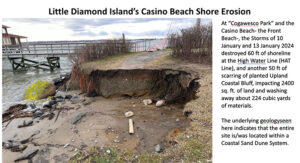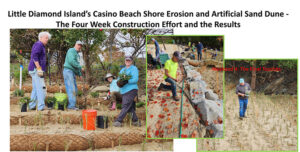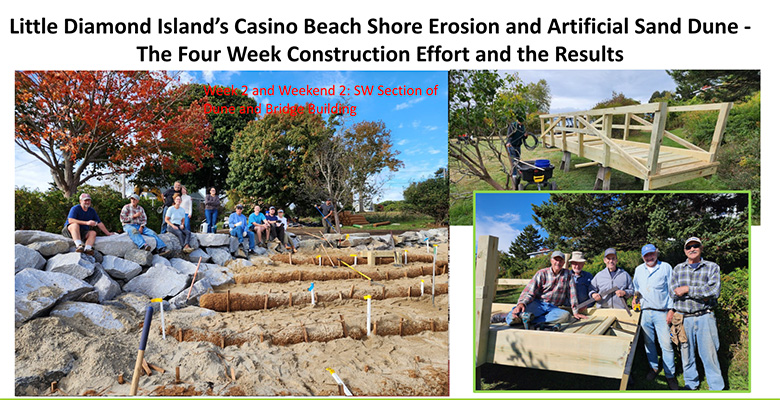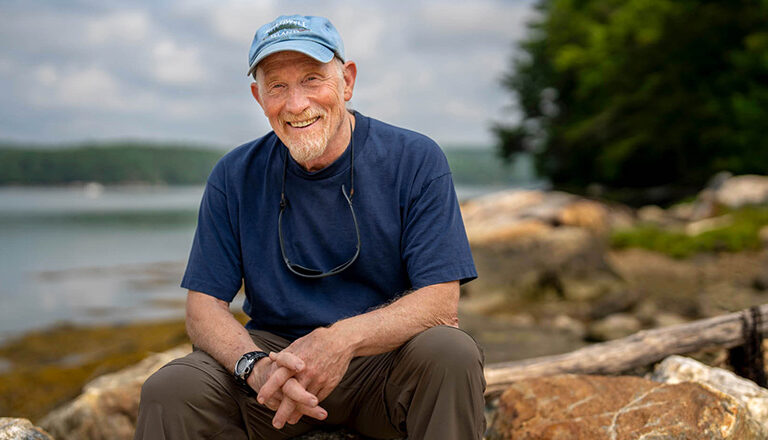In September, I visited the small community of Little Diamond Island in Casco Bay to witness something remarkable: a shoreline restoration project marked by new science and sheer community determination.
Hosted by Island Institute, the event brought together island residents, representatives from neighboring Casco Bay islands, and others eager to learn how coastal communities can protect themselves against the relentless force of the sea.
The story begins in January 2024. Two severe storms battered the island, eroding 60 feet of shoreline along Casino Beach. The waves washed away the community’s golf cart parking area and washed out the road connecting the island to its public dock.

For the small Little Diamond community the damage was devastating. The destruction left the community wondering, “What do we do now?”
Several island leaders responded, and through trial and error, crafted a solution that was as natural as it was strategic: a coastal sand dune system.
Sand dunes are more than beach features. They are living barriers against erosion and storm surges. Acting as sponges for wave energy, dunes protect inland areas from flooding while supporting native vegetation and wildlife.
By planting beach grass, communities can stabilize and prevent sand from washing away, and enable the coastline to rebuild itself naturally. For Little Diamond, this approach was both environmentally responsible and permitted.
At the town hall, known locally as the “Casino,” residents presented their project. Then we walked the short distance to the dune system. The work was impressive. Every contour, log placement, and patch of grass reflected careful planning and countless volunteer hours.
Even with the dunes in place, the project required additional reinforcement. The storms had left a gaping hole along the shoreline, threatening to funnel water directly at the newly constructed dunes. To address this, the gap was filled with crushed rock, creating a natural drainage system to protect the dunes and the rock wall they had constructed behind the dune.
The wall, made of large stones, serves as a backup barrier. While dunes absorb most wave energy, the rock wall ensures that even in extreme conditions, waves won’t breach the island’s infrastructure. It’s a layered approach: dunes first, rocks second, vegetation throughout the dune—a system designed to withstand the sea’s unpredictability.
Next came the work that truly showcased the island’s spirit: volunteers dedicated countless hours to lay “coir” logs along the base and contours of the dunes. Made from tightly bound coconut fibers, coir logs hold sand in place, slow water runoff, and encourage native vegetation to grow. Over time, they biodegrade naturally, leaving behind reinforced dunes ready to withstand wind and waves.

Once the logs were in place, dune grass was planted by hand, then carefully fertilized and watered to ensure it would take root and thrive. By the end of the project, the dunes were not just functional—they were a living testament to the dedication and hard work of the island’s residents.
Now, almost two years after the storms, the dunes blend seamlessly into the shoreline and haven’t sustained any damage. For Little Diamond residents, the project represents more than protection—it embodies pride, resilience, and the power of their community.
The total cost of the project was approximately $140,000, including a $110,000 contract with Lionel Plante Associates and $25,000 for materials supporting volunteer labor.
Little Diamond Island’s approach demonstrates that protecting a shoreline doesn’t always require massive concrete seawalls or expensive engineering projects. A well-designed sand dune system, reinforced with rock walls and supported by native vegetation, can provide a sustainable, cost-effective, and visually appealing solution.
Visiting Little Diamond Island left me with a renewed appreciation for what’s possible when science, planning, and community spirit come together. For coastal towns facing the growing threat of erosion, the lessons here are both practical and inspiring: sometimes, the best defense against the sea is sand, sweat, and shared purpose.
Kai Holloway is an 18-year-old journalist who lives on Cliff Island. He is a feature writer for Islands.com and his blog is at Kaioutside.com.





